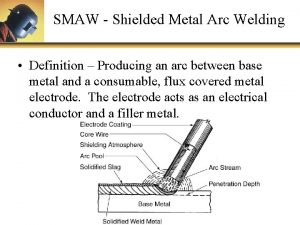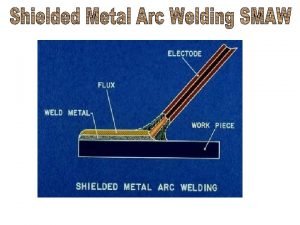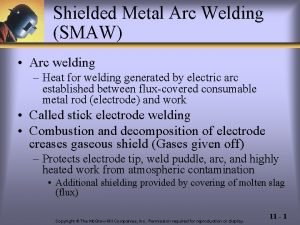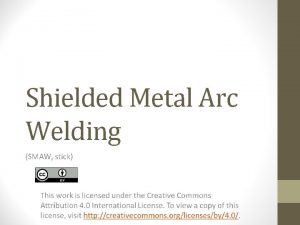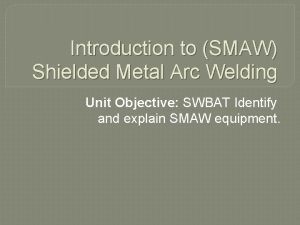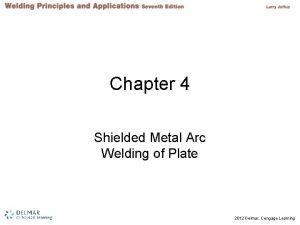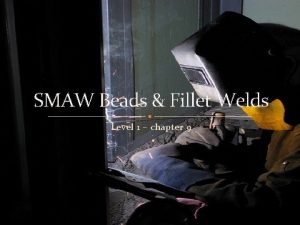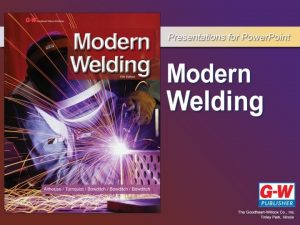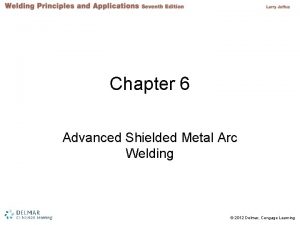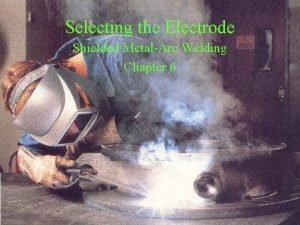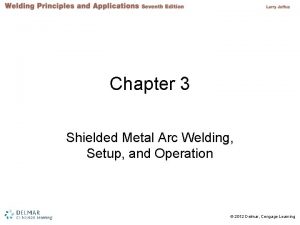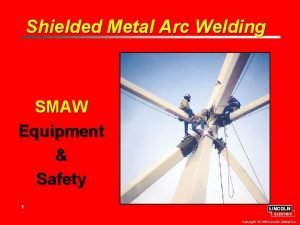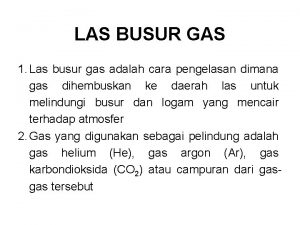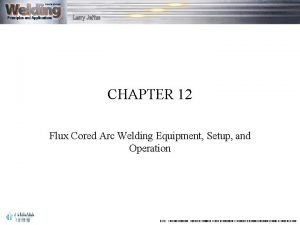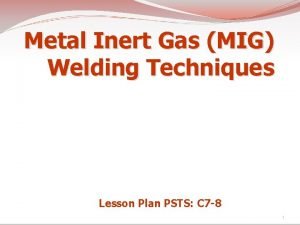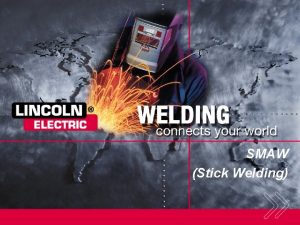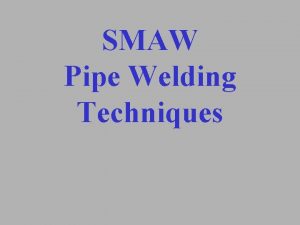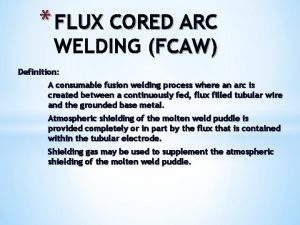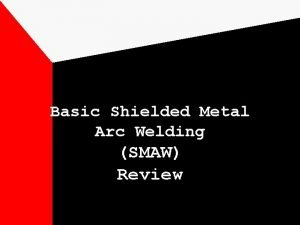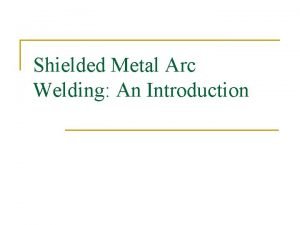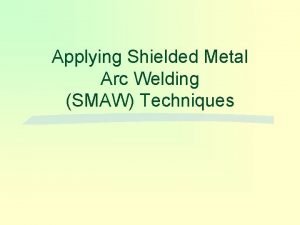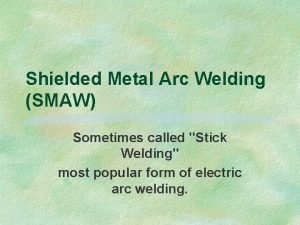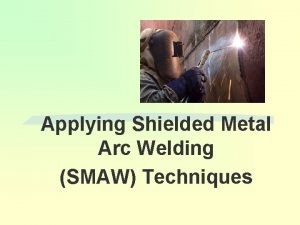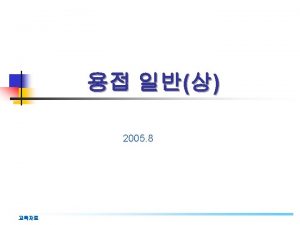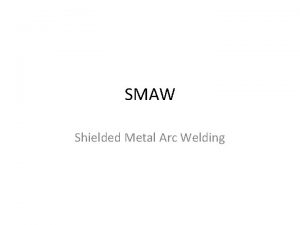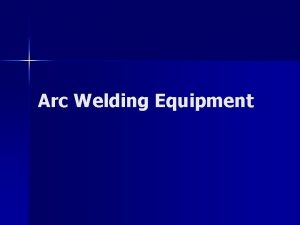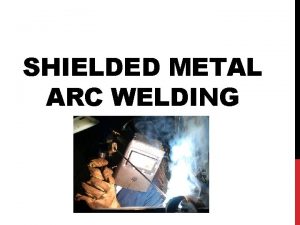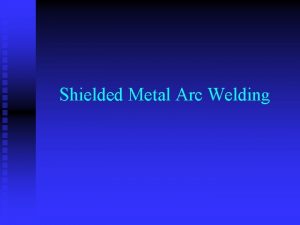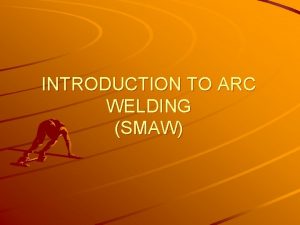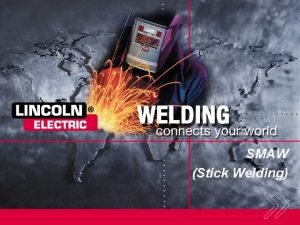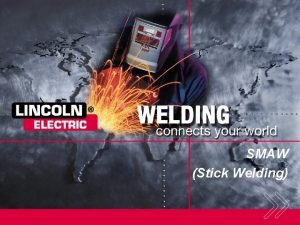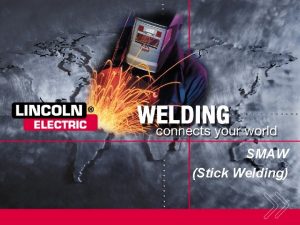SMAW Shielded Metal Arc Welding Definition Producing an























- Slides: 23

SMAW - Shielded Metal Arc Welding • Definition – Producing an arc between base metal and a consumable, flux covered metal electrode. The electrode acts as an electrical conductor and a filler metal.

SMAW Advantages • Equipment less complex, more portable and less costly • Can be done indoors or outdoors, in any location and any position • Electrodes available to match properties and strength of most base metals – Not used for welding softer metals – Not as efficient in deposition

Requirements to Arc Welding • • • Power Source – Either AC or DC Electrode Holder (Stinger) and Cable Work Clamp and Cable Electrode Base Metal 11 - 3

SMAW Operating Principles • Sets up electric circuit – Includes welding machine, work, electric cables, electrode holder and electrodes, and a work clamp • Heat of electric arc brings work to be welded and consumable electrode to molten state – Heat intense: as high at 9, 000ºF at center

Starting, Stopping and Adjusting • Never start the machines under a load • On/Off Switch • Amperage (current) set up by control knob – can be adjusted while welding • Voltage – controlled by the length of the arc gap • - small arc gap = less voltage (cold) • - large arc gap = more voltage (hot) 11 - 5

Electrodes First Letter – “E” is Electric Arc Welding • “ER” is used for Gas Welding First 2 or 3 digits provide the tensile strength in thousands of lbs / in squared • 2 nd digit from the right – recommended position – 1 – All Positions – 2 – Flat or Horizontal – 4 – Flat, Horizontal, overhead, and downhill welding 11 - 6

Electrodes Cont… Last two numbers together represent proper application and covering composition – EXX 11 – High – cellulose, potassium – EXX 13 – High-titania, potassium – EXX 18 – Iron Powder, Low-hydrogen, potassium – – 0, 1 Fast Freeze Rod 2 -9 Filler Rod 11 - 7

Electrodes Cont… As the Electrode melts it accomplishes two tasks – Provides Filler Material - Deposition – How much metal is deposited in the weld. – Flux – Creates a gas that shields the weld and lays down “slag” to allow the weld to cool slowly and remain pure 11 - 8

11 - 9


Striking an Arc • Electrode must first strike the base metal then be withdrawn to the correct arc distance or length. – Stabilizing the Arc • When first starting the Electrode might stick – This is because the arc length is too small • When welding with thin metal – lift the electrode and base metal off of the table • When welding thicker (heavier) metal – release the electrode from the stinger – When the arc length is too great the arc will go out

Striking an Arc Cont… • In order to produce a weld you need to be able to stabilize the arc and create a pool • Scratching Method • Bump Method 11 - 12

Running a Bead • After establishing a stable arc we are ready to create a weld bead • To “run” a good bead requires 4 things • • Arc Gap distance or Arc Length Speed of Travel Correct Amperage Electrode Angle – 15 to 20 degrees in direction of travel 11 - 13

Arc Welding Joints • • • Butt Lapp Corner T-Joint Edge 11 - 14

AC Versus DC Power • Direct Current

AC Versus DC Power • NO Current

AC Versus DC Power • Alternating Current

Safety • Hazards – Radiation from the arc: Ultraviolet and Infrared rays – Flying Sparks and molten globules – Electric Shock – Fumes – Burns

Safety Cont… • Never look at an arc from any distance unless your eyes are protected – Welding Helmets – shade 10 lens – Protects more than just your eyes! • Face, hands, arms, and other skin surfaces must be protected – burns are comparable to sun burns

Safety Cont… • Flammable Materials • Avoid welding in wet or damp areas • Always weld in areas that are well ventilated 11 - 20

Protective Clothing Copyright © The Mc. Graw-Hill Companies, Inc. Permission required for reproduction or display. 11 - 21

Procedures • Make sure you have all safety materials – gloves, clothing, safety glasses, welding helmets • Electrode Check-out procedures • Partners • Metal 11 - 22

Procedures Cont… • Use pliers or tongs to handle hot metal – When leaving hot metal lying around please mark on it with a piece of soapstone – HOT – Don’t ever under any circumstances hand me a piece of hot metal!! – Use the tanks outside to cool off metal 11 - 23
 Shielded metal arc welding meaning
Shielded metal arc welding meaning Smaw
Smaw Smw process
Smw process Shielded metal arc welding definition
Shielded metal arc welding definition Tools in smaw
Tools in smaw What size electrode was used to make the 1f lap joint weld?
What size electrode was used to make the 1f lap joint weld? Why is sma welding current referred to as constant current?
Why is sma welding current referred to as constant current? Beads and fillet welds
Beads and fillet welds Chapter 6 shielded metal arc welding
Chapter 6 shielded metal arc welding Chapter 6 shielded metal arc welding
Chapter 6 shielded metal arc welding Cover pass welding definition
Cover pass welding definition Chapter 3 shielded metal arc welding
Chapter 3 shielded metal arc welding What is smaw
What is smaw Las busur adalah
Las busur adalah Fcaw welding process
Fcaw welding process Welding lesson plans
Welding lesson plans Smaw welding lesson plans
Smaw welding lesson plans Smaw safety
Smaw safety Smaw overhead welding techniques
Smaw overhead welding techniques Flux definition in welding
Flux definition in welding Spraggins fitness
Spraggins fitness Arc promoteur vs arc investigateur
Arc promoteur vs arc investigateur Minor and major arcs
Minor and major arcs What is minor arc
What is minor arc
